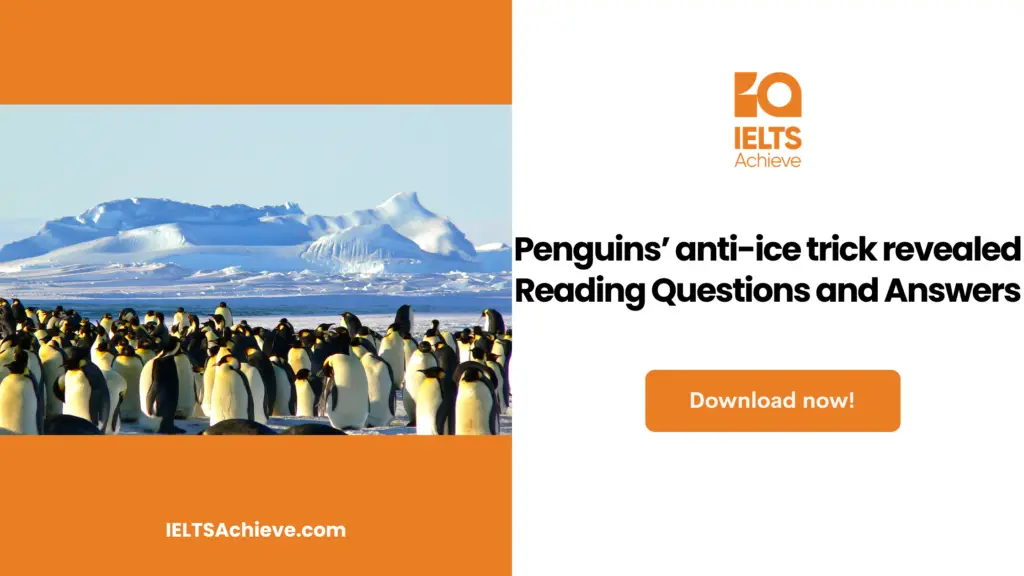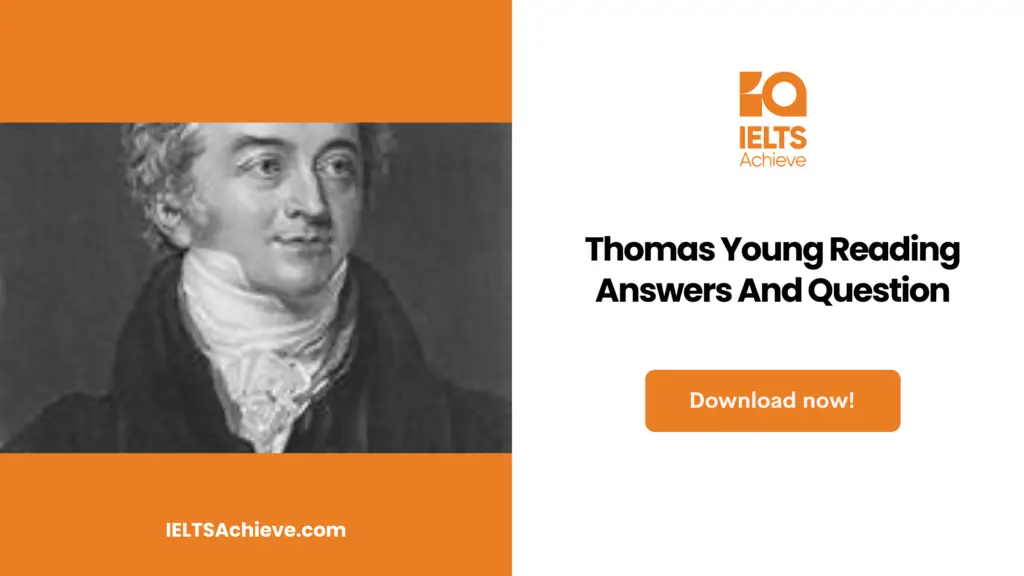The Blog post contains the following IELTS Reading Questions:
- IELTS Reading Multiple Choice Questions
- IELTS Reading Sentence Completion
Stay informed and prepared for success – Explore our comprehensive Reading Test Info page to get valuable insights, exam format details, and expert tips for mastering the IELTS Reading section.
IELTS Reading Passage – Penguins’ anti-ice trick revealed

Penguins’ anti-ice trick revealed
Scientists studying penguins’ feathers have revealed how the birds stay ice free when hopping in and out of below zero waters in the Antarctic. A combination of nano-sized pores and an extra water repelling preening oil the birds secrete is thought to give Antarctic penguins’ feathers superhydrophobic properties. Researchers in the US made the discovery using Scanning Electron Microscopy (SEM) to study penguin feathers in extreme detail. Antarctic penguins live in one of Earth’s most extreme environments, facing temperatures that drop to -40C, winds with speeds of 40 metres per second and water that stays around -2.2C. But even in these sub-zero conditions, the birds manage to prevent ice from coating their feathers.
“They are an amazing species, living in extreme conditions, and great swimmers. Basically they are living engineering marvels,” says research team member Dr Pirouz Kavehpour, professor of Mechanical and Aerospace Engineering at the University of California, Los Angeles (UCLA). Birds’ feathers are known to have hydrophobic, or non-wetting, properties. But scientists from UCLA, University of Massachusetts Amherst and SeaWorld, wanted to know what makes Antarctic penguins’ feathers extra ice repelling.
“What we learn here is how penguins combine oil and nano-structures on the feathers to produce this effect to perfection,” explains Kavehpour. By analysing feathers from different penguin species, the researchers discovered Antarctic species the gentoo penguin (Pygoscelis papua) was more superhydrophobic compared with a species found in warmer climes – the Magellanic penguin (Spheniscus magellanicus) – whose breeding sites include Argentinian desert.
Gentoo penguins’ feathers contained tiny pores which trapped air, making the surface hydrophobic. And they were smothered with a special preening oil, produced by a gland near the base of the tail, with which the birds cover themselves. Together, these properties mean that in the wild, droplets of water on Antarctic penguins’ superhydrophobic feathers bead up on the surface like spheres – formations that, according to the team, could provide geometry that delays ice formation, since heat cannot easily flow out of the water if the droplet only has minimal contact with the surface of the feather.
“The shape of the droplet on the surface dictates the delay in freezing,” explains Kavehpour. The water droplets roll off the penguin’s feathers before they have time to freeze, the researchers propose. Penguins living in the Antarctic are highly evolved to cope with harsh conditions: their short outer feathers overlap to make a thick protective layer over fluffier feathers which keep them warm. Under their skin, a thick layer of fat keeps them insulated. The flightless birds spend a lot of time in the sea and are extremely agile and graceful swimmers, appearing much more awkward on land.
Kavehpour was inspired to study Antarctic penguins’ feathers after watching the birds in a nature documentary: “I saw these birds moving in and out of water, splashing everywhere. Yet there is no single drop of frozen ice sticking to them,” he tells BBC Earth. His team now hopes its work could aid design of better man-made surfaces which minimise frost formation.
“I would love to see biomimicking of these surfaces for important applications, for example, de-icing of aircrafts,” says Kavehpour. Currently, airlines spend a lot of time and money using chemical de-icers on aeroplanes, as ice can alter the vehicles’ aerodynamic properties and can even cause them to crash.
Unlock your full potential in the IELTS Reading section – Visit our IELTS Reading Practice Question Answer page now!
Recommended Questions:
Renewable Energy IELTS Reading Question with Answer
Questions 29-33
Choose the correct letter, A, B, C or D.
29. Penguins stay ice free due to
A A combination of nano-sized pores
B An extra water repelling preening oil
C A combination of nano-sized pores and an extra water repelling preening oil
D A combination of various factors
30. Antarctic penguins experience extreme weather conditions, including:
A Low temperature, that can drop to -40
B Severe wind, up to 40 metres per second
C Below zero water temperature
D All of the above
31. In line 5 words engineering marvels mean:
A That penguins are very intelligent
B That penguins are good swimmers
C That penguins are well prepared to living in severe conditions
D Both B and C
32. Penguins feather has everything, EXCEPT:
A Hydrophobic properties
B Extra ice repelling
C Soft structures
D Oil structures
33. The gentoo penguin:
A Is less superhydrophobic compared to the Magellanic penguin
B Has feathers that contain tiny pores
C Can’t swim
D Lives in Argentinian desert
Ready to improve your performance in Multiple Choice Questions (MCQs)? Click here to access our comprehensive guide on how to tackle MCQs effectively in the IELTS Reading section.
Questions 34-40
Complete the sentences below. Write ONLY ONE WORD from the passage for each answer.
Formations like (34)…………………….could provide geometry that delays ice formation.
The delay in freezing is dictated by the (35)………………….of the droplet.
Penguins in Antarctic are highly evolved to be able to cope with (36)……………….conditions.
Penguins are insulated by a (37)…………………….layer of fat.
On the land, penguins appear much more (38)………………………than in the sea.
The inspiration came to Kavehpour after watching a (39)…………………..about penguins.
Kavehpour would like to see (40)……………………..surfaces which minimise frost formation.
Enhance your sentence completion skills in the IELTS Reading section. Click here to access our comprehensive guide and learn effective strategies for filling in missing words or phrases in sentences.
Unlock your full potential in the IELTS Reading section – Visit our IELTS Reading Practice Question Answer page now!
Recommended Questions:
Renewable Energy IELTS Reading Question with Answer

We hope you found this post useful in helping you to study for the IELTS Test. If you have any questions please let us know in the comments below or on the Facebook page.
The best way to keep up to date with posts like this is to like us on Facebook, then follow us on Instagram and Pinterest. If you need help preparing for the IELTS Test, join the IELTS Achieve Academy and see how we can assist you to achieve your desired band score. We offer an essay correction service, mock exams and online courses.


